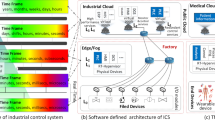Abstract
The process of large-scale manufacturing workshops is complex, and the traditional fixed resource allocation method will cause unbalanced load. Aiming at this problem, an edge-side server resource allocation algorithm based on cloud collaborative architecture has been designed and implemented. By defining the three-dimensional information of each IO-intensive virtual machine in the compute node, the priority of the IO-intensive virtual machine is calculated. Through analyzing the relationship between the CPU-intensive virtual machine and the host physical machine, the number of CPU cores for different tasks of the CPU-intensive virtual machine is obtained, and the hardware resources are uniformly allocated in real time according to the maximum priority list. The experimental results show that the proposed algorithm can significantly satisfy the requirements of high throughput and low latency in large manufacturing workshops, and optimize the resource allocation for actual production.
Access this chapter
Tax calculation will be finalised at checkout
Purchases are for personal use only
Similar content being viewed by others
References
Li, L.: China's manufacturing locus in 2025: with a comparison of “Made-in-China 2025” and “Industry 4.0”. Technol. Forecast. Soc. Change 135, 66–74 (2018)
Zhou, J.: Toward New-generation intelligent manufacturing. Engineering 4(1), 28–47 (2018)
Stark, R.: Development and operation of Digital Twins for technical systems and services. CIRP Ann. 68(1), 129–132 (2019)
Shen, W.: Potential applications of 5G communication technologies in collaborative intelligent manufacturing. IET Collab. Intell. Manuf. 1(4), 109–116 (2019)
Xu, L.D.: Big data for cyber physical systems in industry 4.0: a survey. Enterp. Inf. Syst. 13(2), 148–169 (2019)
Jena, M.C.: Application of Industry 4.0 to enhance sustainable manufacturing. Environ. Prog. Sustain. Energy 39(1), 13360 (2020)
Song, T.: Server consolidation energy-saving algorithm based on resource reservation and resource allocation strategy. IEEE Access 7, 171452–171460 (2019)
Rugwiro, U.: Task scheduling and resource allocation based on ant-colony optimization and deep reinforcement learning. J. Internet Technol. 20(5), 1463–1475 (2019)
Devarasetty, P.: Genetic algorithm for quality of service based resource allocation in cloud computing. Evol. Intel. 16(4), 1–7 (2019). https://doi.org/10.1007/s12065-019-00233-6
Jangiti, S.: Scalable hybrid and ensemble heuristics for economic virtual resource allocation in cloud and fog cyber-physical systems. J. Intell. Fuzzy Syst. 36(5), 4519–4529 (2019)
Liu, C.F.: Dynamic task offloading and resource allocation for ultra-reliable low-latency edge computing. IEEE Trans. Commun. 67(6), 4132–4150 (2019)
Liao, H.: Learning-based context-aware resource allocation for edge-computing-empowered industrial IoT. IEEE Internet Things J. 7(5), 4260–4277 (2019)
Hu, A., Xiang, L., Xu, S., Lin, J.: Frequency loss and recovery in rolling bearing fault detection. Chin. J. Mech. Eng. 32(1), 1–12 (2019). https://doi.org/10.1186/s10033-019-0349-3
Shen, G.: A study of the condition monitoring of large mechanical equipment based on a health management theory for mechanical systems. Insight Nondestr. Test. Condition Monit. 61(8), 448–457 (2019)
Zhang, J.X.: Cloud collaborative computing framework for a service robot based on ROS. Comput. Syst. Appl. 25(9), 85–91 (2016)
Merlino, G.: Enabling workload engineering in edge, fog, and cloud computing through OpenStack-based middleware. ACM Trans. Internet Technol. 19(2), 28–30 (2019)
An overview of the StarlingX project. https://www.starlingx.io/learn/. Accessed 15 May 2020
Zhu, J.: Research on data mining of electric power system based on Hadoop cloud computing platform. Int. J. Comput. Appl. 41(4), 289–295 (2019)
Yamato, Y.: Fast and reliable restoration method of virtual resources on OpenStack. IEEE Trans. Cloud Comput. 6(2), 572–576 (2018)
Yi, C.: Quaternion singular spectrum analysis using convex optimization and its application to fault diagnosis of rolling bearing. Measurement 103(6), 321–323 (2017)
Chen, F., Fu, Z., Zhen, L.: Thermal power generation fault diagnosis and prediction model based on deep learning and multimedia systems. Multimedia Tools Appl. 78(4), 4673–4692 (2018). https://doi.org/10.1007/s11042-018-6601-5
Huang, Y.: M/M/n/m queuing model under nonpreemptive limited-priority. Chin. J. Appl. Probab. Stat. 34(4), 364–368 (2018)
Peng, J., Chen, J., Kong, S.: Resource optimization strategy for CPU intensive applications in cloud computing environment. In: IEEE 3rd International Conference on Cyber Security and Cloud Computing 2016, CSCloud, Beijing, vol. 10134, pp. 124–128. IEEE (2016)
Hu, N.: Power equipment status information parallel fault diagnosis of based on MapReduce. J. Comput. Methods Sci. Eng. 19(1), 165–170 (2019)
Zhi, Y.: Balance resource allocation for spark jobs based on prediction of the optimal resource. Tsinghua Sci. Technol. 25(04), 487–497 (2020)
Zhang, J.: Big data driven intelligent manufacturing. China Mech. Eng. 30(2), 127–133 (2019)
StarlingX Enhancements for Edge Networking, [EB/OL] (2018). https://www.openstack.org/videos/summits/berlin-2018/starlingx-enhancements-for-edge-networknet. Accessed 15 May 2020
Guo, W., Kuang, P., Jiang, Y., Xu, X., Tian, W.: SAVE: self-adaptive consolidation of virtual machines for energy efficiency of CPU-intensive applications in the cloud. J. Supercomput. 75(11), 7076–7100 (2019). https://doi.org/10.1007/s11227-019-02927-1
Merlino, G.: Enabling workload engineering in edge, fog, and cloud computing through OpenStack-based middleware. ACM Trans. Internet Technol. (TOIT) 19(2), 1–22 (2019)
Al-Tarazi, M., Chang, J.M.: Network-aware energy saving multi-objective optimization in virtualized data centers. Clust. Comput. 22(2), 635–647 (2018). https://doi.org/10.1007/s10586-018-2869-5
Cao, Y.: Communication optimisation for intermediate data of MapReduce computing model. Int. J. Comput. Sci. Eng. 21(2), 226–233 (2020)
Acknowledgement
This paper is supported by Natural Science Foundation of China (No. 61871432, No. 61702178), The Natural Science Foundation of Hunan Province (No. 2020JJ4275, 2020JJ6086, 2019JJ60008, 2018JJ4063).
Author information
Authors and Affiliations
Corresponding author
Editor information
Editors and Affiliations
Rights and permissions
Copyright information
© 2021 ICST Institute for Computer Sciences, Social Informatics and Telecommunications Engineering
About this paper
Cite this paper
Man, J., Zhao, L., Peng, C., Li, Q. (2021). Resource Allocation Method of Edge-Side Server Based on Two Types of Virtual Machines in Cloud and Edge Collaborative Computing Architecture. In: Jiang, H., Wu, H., Zeng, F. (eds) Edge Computing and IoT: Systems, Management and Security. ICECI 2020. Lecture Notes of the Institute for Computer Sciences, Social Informatics and Telecommunications Engineering, vol 368. Springer, Cham. https://doi.org/10.1007/978-3-030-73429-9_5
Download citation
DOI: https://doi.org/10.1007/978-3-030-73429-9_5
Published:
Publisher Name: Springer, Cham
Print ISBN: 978-3-030-73428-2
Online ISBN: 978-3-030-73429-9
eBook Packages: Computer ScienceComputer Science (R0)




